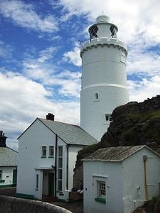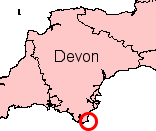
Start Point lighthouse
Encyclopedia
Start Point lighthouse was built in 1836 to protect shipping off Start Point
in south Devon
England
. Open to the public in summer months, it is a grade II listed building owned and operated by Trinity House
.
. The lighthouse is in the gothic style
, topped by a crenellated parapet
. The main tower is built of tarred and white-painted granite
ashlar with a cast-iron lantern roofed in copper
. The tall circular tower is 28 metres (92 ft) high with a moulded plinth and pedestal stage and two diminishing stages above that. There are two entrances porches, on the north and south sides. The porch on the south side is blocked and has a 4-centred arch hoodmould, whilst the doorway to the north porch has a Tudor arch. Both have raised parapets with Trinity House arms.
The inside of the tower includes a cantilevered granite staircase around the inside well of the tower with an iron
balustrade
completed by a cast-iron newelan. The lighthouse originally had the keepers' living accommodation on the ground and first floors but this was removed in 1871 when new keepers' houses were built nearby. It has been designated by English Heritage
as a grade II listed building.
Work began on the automation of Start Point Lighthouse in August 1992 and was carried out by LEC Marine at a cost of £82,754. It was completed in early 1993. The station is now monitored and controlled from the Trinity House Operations Control Centre at Harwich
in Essex
via a telemetry
link.
, the first of this kind to be used by Trinity House. Two white lights were originally exhibited, one revolving and one fixed to mark the Skerries Bank. The fixed light was subsequently changed to a fixed red subsidiary light to mark this hazard. The light was powered by oil until 1959 when it was electrified. It uses a Fresnel lens
.
 The light alone was found to be inadequate in fog, and a bell was installed in the 1860s. The machinery was housed in a small building on the cliff face and operated by a weight which fell in a tube running down the sheer cliff. A siren replaced the bell after only fifteen years. When required the foghorn
The light alone was found to be inadequate in fog, and a bell was installed in the 1860s. The machinery was housed in a small building on the cliff face and operated by a weight which fell in a tube running down the sheer cliff. A siren replaced the bell after only fifteen years. When required the foghorn
sounds once every 60 seconds.
Start Point, Devon
Start Point is a promontory in the South Hams district. It is one of the most southerly points in Devon, England, . It marks the southern limit of Start Bay, which extends northwards to the estuary of the River Dart....
in south Devon
Devon
Devon is a large county in southwestern England. The county is sometimes referred to as Devonshire, although the term is rarely used inside the county itself as the county has never been officially "shired", it often indicates a traditional or historical context.The county shares borders with...
England
England
England is a country that is part of the United Kingdom. It shares land borders with Scotland to the north and Wales to the west; the Irish Sea is to the north west, the Celtic Sea to the south west, with the North Sea to the east and the English Channel to the south separating it from continental...
. Open to the public in summer months, it is a grade II listed building owned and operated by Trinity House
Trinity House
The Corporation of Trinity House of Deptford Strond is the official General Lighthouse Authority for England, Wales and other British territorial waters...
.
Construction
Start Point is one of twenty nine towers designed by James WalkerJames Walker (engineer)
James Walker, FRS, was an influential Scottish civil engineer of the first half of the 19th century.Walker was born in Falkirk and was apprenticed to his uncle Ralph Walker in approximately 1800, with whom he gained experience working on the design and construction of the West India and East India...
. The lighthouse is in the gothic style
Gothic architecture
Gothic architecture is a style of architecture that flourished during the high and late medieval period. It evolved from Romanesque architecture and was succeeded by Renaissance architecture....
, topped by a crenellated parapet
Parapet
A parapet is a wall-like barrier at the edge of a roof, terrace, balcony or other structure. Where extending above a roof, it may simply be the portion of an exterior wall that continues above the line of the roof surface, or may be a continuation of a vertical feature beneath the roof such as a...
. The main tower is built of tarred and white-painted granite
Granite
Granite is a common and widely occurring type of intrusive, felsic, igneous rock. Granite usually has a medium- to coarse-grained texture. Occasionally some individual crystals are larger than the groundmass, in which case the texture is known as porphyritic. A granitic rock with a porphyritic...
ashlar with a cast-iron lantern roofed in copper
Copper
Copper is a chemical element with the symbol Cu and atomic number 29. It is a ductile metal with very high thermal and electrical conductivity. Pure copper is soft and malleable; an exposed surface has a reddish-orange tarnish...
. The tall circular tower is 28 metres (92 ft) high with a moulded plinth and pedestal stage and two diminishing stages above that. There are two entrances porches, on the north and south sides. The porch on the south side is blocked and has a 4-centred arch hoodmould, whilst the doorway to the north porch has a Tudor arch. Both have raised parapets with Trinity House arms.
The inside of the tower includes a cantilevered granite staircase around the inside well of the tower with an iron
Iron
Iron is a chemical element with the symbol Fe and atomic number 26. It is a metal in the first transition series. It is the most common element forming the planet Earth as a whole, forming much of Earth's outer and inner core. It is the fourth most common element in the Earth's crust...
balustrade
Baluster
A baluster is a moulded shaft, square or of lathe-turned form, one of various forms of spindle in woodwork, made of stone or wood and sometimes of metal, standing on a unifying footing, and supporting the coping of a parapet or the handrail of a staircase. Multiplied in this way, they form a...
completed by a cast-iron newelan. The lighthouse originally had the keepers' living accommodation on the ground and first floors but this was removed in 1871 when new keepers' houses were built nearby. It has been designated by English Heritage
English Heritage
English Heritage . is an executive non-departmental public body of the British Government sponsored by the Department for Culture, Media and Sport...
as a grade II listed building.
Changes since construction
Since its construction, in 1836, the lighthouse has undergone many changes. In 1862, a fog-signalling bell was added but this was quickly replaced by a siren in 1877. In 1989, the erosion of the coast caused part of the lighthouse complex, including the fog signal, to collapse. A lot of the area had to be leveled as a result and retaining walls put in place. Other buildings which were used by the lighthouse keepers, who originally could only get on or off the lighthouse by boat, such as the well and piggery have survived.Work began on the automation of Start Point Lighthouse in August 1992 and was carried out by LEC Marine at a cost of £82,754. It was completed in early 1993. The station is now monitored and controlled from the Trinity House Operations Control Centre at Harwich
Harwich
Harwich is a town in Essex, England and one of the Haven ports, located on the coast with the North Sea to the east. It is in the Tendring district. Nearby places include Felixstowe to the northeast, Ipswich to the northwest, Colchester to the southwest and Clacton-on-Sea to the south...
in Essex
Essex
Essex is a ceremonial and non-metropolitan county in the East region of England, and one of the home counties. It is located to the northeast of Greater London. It borders with Cambridgeshire and Suffolk to the north, Hertfordshire to the west, Kent to the South and London to the south west...
via a telemetry
Telemetry
Telemetry is a technology that allows measurements to be made at a distance, usually via radio wave transmission and reception of the information. The word is derived from Greek roots: tele = remote, and metron = measure...
link.
Optics
The lens is developed from the dioptic system designed by Alan StevensonAlan Stevenson
Alan Stevenson FRSE MInstCE was a Scottish lighthouse engineer who was Engineer to the Board of Northern Lighthouses...
, the first of this kind to be used by Trinity House. Two white lights were originally exhibited, one revolving and one fixed to mark the Skerries Bank. The fixed light was subsequently changed to a fixed red subsidiary light to mark this hazard. The light was powered by oil until 1959 when it was electrified. It uses a Fresnel lens
Fresnel lens
A Fresnel lens is a type of lens originally developed by French physicist Augustin-Jean Fresnel for lighthouses.The design allows the construction of lenses of large aperture and short focal length without the mass and volume of material that would be required by a lens of conventional design...
.
Foghorn

Foghorn
A foghorn or fog signal or fog bell is a device that uses sound to warn vehicles of hazards or boats of the presence of other vehicles in foggy conditions. The term is most often used in relation to marine transport...
sounds once every 60 seconds.

